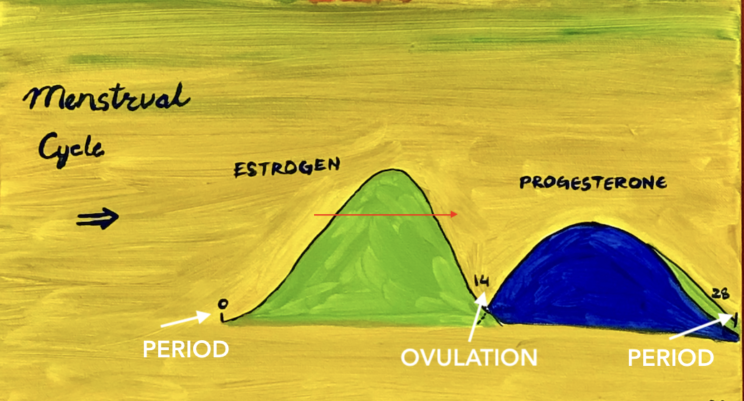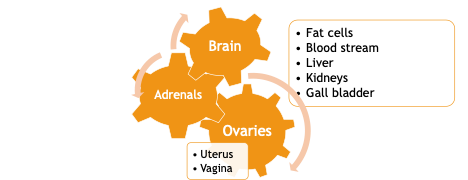We often get labelled as emotional, crazy, labile and on and on!
- What is really going on?
- What is PMS?
- When do you need to seek help?
- How to manage it?
- Are anti-depressants the answer??
Read on to learn what PMS or PMDD is and how you can feel better so you can go on and be the rockstar that you are!
What is PMS?
PMS is a basket full of physical and emotional symptoms that are;
- cyclical
- appear 7-10 days before your period and then resolve when the period comes.
- symptoms can vary anywhere from;
- bloating
- weight gain
- fatigue
- depression
- irritability
- mental fog
- sleeplessness,
- low sex drive
- worsening migraines
- stomach issues
- acne
- allergies and so much more.
What is PMDD?
Premenstrual dysphoric disorder (PMDD) is a more severe form of PMS that affects your lifestyle and interferes with your ability to function and perform your daily activities.
Who gets PMS or PMDD?
- Over 70% of cycling women report some symptoms of PMS.
- However, clinically significant symptoms of PMS occur in nearly 30% of women and 2-3% of women suffer from clinical PMDD.
- The symptoms are often underreported because women often suffer in silence.
Who is at risk?
Everyone and anyone who gets periods can get these symptoms since PMS symptoms are associated with menstrual cycles. Read on as we explain the mechanism below.
- Overweight or obese women may have a slightly higher risk.
- Life changing events such as child birth, the loss of a loved one, a job or a significant change can also trigger the onset of PMS symptoms.
Why does PMS happen?
There are many proposed theories. Recent studies suggest some of the below mechanisms:
- High estrogen throughout the cycle or an improper fall in the cycle.
- Improper rise of progesterone in the second half of the cycle after ovulation.
- Serotonin imbalance happening due to abnormal FSH and LH pulses controlling the menstrual cycle.
What happens in a normal menstrual cycle and what happens in PMS?

A normal full menstrual cycle is counted from the day the period starts until the beginning of the next period. Normally, it can range from 25-35 days.
Days 1-12
The first day of bleeding is counted as Day 1:
- As the period starts, the estrogen levels slowly start to rise under the influence of the brain hormone called FSH.
- The estrogen helps prepare the uterine lining develop a nice cushy base in case a pregnancy may occur in the cycle.
- The estrogen also tells the premature eggs in the ovary to start prepping and getting one of the eggs ready for ovulation.
- This goes on for about 12-14 days (depending on the cycle duration).
Days 12-14
Around day 12, the other hormone called LH starts to rise:
- This is a signal for the ovary to get ready for ovulation.
Days 14-28
Around day 14, both the LH and FSH levels drop:
- This triggers ovulation.
- Ovulation simply means that the one fully developed egg is released from the ovary into the pelvis.
- Some women may experience a sharp pain called mittelschmerz at this time and some may not experience anything.
- This is the time that the sperm will need to find the mature egg and go and fertilize it. Hence, timing is critical in case you want to conceive.
- Once the FSH and LH levels drop, the egg is released.
- Simultaneously, the estrogen levels also drop.
This takes us into the second half of the menstrual cycle.
- At this point, the progesterone levels start to rise slowly.
- The progesterone peaks at around day 22-24 and then declines slowly.
- At the same time, estrogen rises slowly again but this time, it’s levels are much lower.
Around Day 25 to Day 28:
- The estrogen and progesterone levels drop suddenly.
- The sharp drop in the levels, triggers the period and the soft and cushy uterine lining sheds which forms your period.
Then cycle starts all over again….
So, what happens in PMS?
Any of the steps in the above sequence may be off…meaning they may not be happening enough or may not be in sync.
You may experience PMS symptoms if:
- If the progesterone in the second half of the cycle not enough or;
- The progesterone does not rise at the right time or;
- Estrogen does not fall correctly;
- Estrogen dominance symptoms include, weight gain, bloating, breast tenderness and mood changes etc.
Why do the above abnormalities in the hormonal patterns occur?
This is because our bodies are an intricately connected web system. Hormones are produced by the brain, adrenals, fat cells, ovaries etc. can be affected by any small change.
Small changes can be such as;
- physical or emotional stress
- dietary imbalances
- medical conditions
- genetic imbalances (SNPs)
- nutrient deficiencies and so much more
- Incorrect timing or strength of hormonal rhythm can create messy cacophony instead of a well synchronized musical orchestra.

How can we diagnose PMS or PMDD?
Mainly by symptoms!
If the symptoms are:
- Cyclical
- Relieved with the period
- Strong enough to affect your day-to-day function, relationships and productivity then you probably have something going on!
What tests can be done to diagnose or confirm PMS?
- Hormone testing
Saliva test:
- Doing a full 28-day hormonal testing through the saliva can provide us with a window into what might be happening your body.
- This test is specialized and is still not a “mainstream” test.
- It is done by specialized labs and is mostly not covered by your insurance.
Blood test:
- A baseline blood test to check all the hormones including thyroid hormones helps find anything else that might be causing similar symptoms.
- However, a blood test only gives us a very tiny glimpse into the hormonal complex.
- One test cannot show if you have estrogen – progesterone – LH – FSH imbalance.
- Blood test results will vary depending on when the tests were done in you cycle as described above.
How can we fix PMS?
As always, we recommend a full comprehensive LAMPS approach? There is no one size fits all wonder drug. It requires a customized approach for each and every one of you.
Let’s break down the components of the LAMPS approach that will help you kick the PMS butt!
- L- Lifestyle
- A- Alternative medicine
- M- Medications
- P- Physical health
- S – Social health
L-LIFESTYLE
Foods
- Magnesium rich foods help regulate the smooth muscle relaxation and blood flow thus relieving some PMS symptoms. These include:
- Green leafy vegetables such as spinach.
- Avocadoes
- Lentils
- Green beans
- Wheat germ
- Oat bran
2) Diuretic foods help reduce swelling, water retention and improve bloating and breast tenderness.
-
-
- Parsley
- Strawberries
-
3) Estrogen dominance fighting foods help promote healthier processing of estrogen in our liver and gut. These include:
-
- Cruciferous vegetables such as cauliflower, brussels sprouts and cabbage etc.
- Cilantro
- Thyme
4) Caffeine restriction and reducing salt intake helps with PMS symptoms such as bloating and swelling.
Eating patterns
- Do not skip meals.
- If practicing intermittent fasting, have a healthy, high protein (or fat) breakfast.
- Drink 10-15 glasses of plain water all day.
- Have consistent eating patterns.
- Develop consistent sleep-wake cycles.
A-ALTERNATIVE APPROACH
Various herbal regimens and supplements can assist with the symptoms of PMS.
Below are some specific recommendations that have shown to assist with relief of PMS symptoms:
- Evening primrose oil
- Magnesium glycinate or threonate
- Omega 3
- Vitamin D
- Calcium
- Vitamin A
- Chasteberry
- Black cohosh
- B- vitamins
- Folate, specifically methylated folate
Please do not take the herbal supplements without supervision since some of them may interact with your medications or cause other symptoms such as abnormal bleeding etc.
We can assist and customize the list for you.
M- MEDICATIONS
- Progesterone (Bio-identical)
- Progesterone supplementation during the second half of the cycle (after ovulation) can help markedly relieve symptoms such as mental fog, irritability, fatigue etc.
- A full 28-day salivary test can help customize exactly how much you need and when.
- Antidepressants
- Antidepressants such as Lexapro, Zoloft or Wellbutrin etc. can give you short term relief.
- We do not recommend these for relief of PMS or PMDD due to long term side effects such as;
- Dependence
- Weight gain – which can lead to more estrogen production and which can worsen the underlying hormonal imbalance.
- Water retention
- Mental fog
- Fatigue
- Low libido
P – PHYSICAL HEALTH
- Rest and relaxation is key.
- Get at least 8 hours of sleep if possible.
- Do a meditative practice 3 days a week.
- Practice slow, contemplative exercise such as yoga 2-3 times a week.
- Aerobic exercise 3 times a week has been shown to improve the symptoms of PMS.
Need a guided weekly plan? We can help!
S – SOCIAL HEALTH
- Think positive.
- You are not alone.
- Get a PMS buddy and have daily – weekly- monthly check-ins.
- Have a shutdown protocol.
- Have a wake-up ritual
- Try a consistent sleep-wake cycle.
Key take aways!!
PMS is not a disease
You are not broken
You are not crazy
You are not alone
There is help out there. We can assist you with a custom functional medicine and lifestyle approach. Just ask!! Watch the full video here.
Be safe, be strong and be prepared!
Walk In GYN Team

